Tested: 1991 Chevrolet Corvette ZR-1 vs. Porsche 911 Turbo
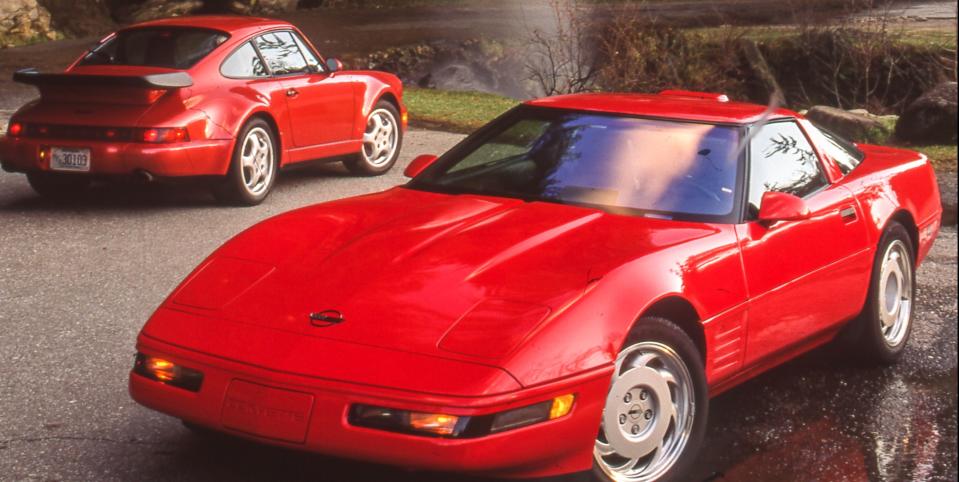
From the April 1991 issue of Car and Driver.
This is a territorial dispute, a grudge match between two longtime enemies determined to dominate one another—and determined to gain control of the turf they have fought over for years. These are two wild animals sharing one clearly focused purpose: speed. Beneath the skin-tight sheetmetal, their ferocious hearts pound with pent-up power. They prowl the streets like jungle cats.
The Porsche 911 Turbo and the Chevrolet Corvette ZR-1 are predators of the road.
The rivalry between these two models goes back to 1965, the year the 911 first appeared. These two cars have always tried to achieve the same goals—all-conquering performance and handling—but in vastly different ways. The German approach emphasizes Son of Beetle technology: the six-cylinder engine is smaller in displacement, air-cooled, and horizontally opposed, and it's shoehorned into the stubby tail of a compact, lightweight body. Everyone knows the American way: more is better. A husky steel chassis is wrapped in fiberglass skin and stuffed with a massive, front-mounted V-8.
Over the years, the battle for superiority has shifted back and forth, as first one and then the other upped the ante with a variety of strategies: better suspensions, more power, more efficient aerodynamics. This perennial contest has resulted in the two cars you see here, the most powerful versions of the Corvette and 911 ever sold in America.
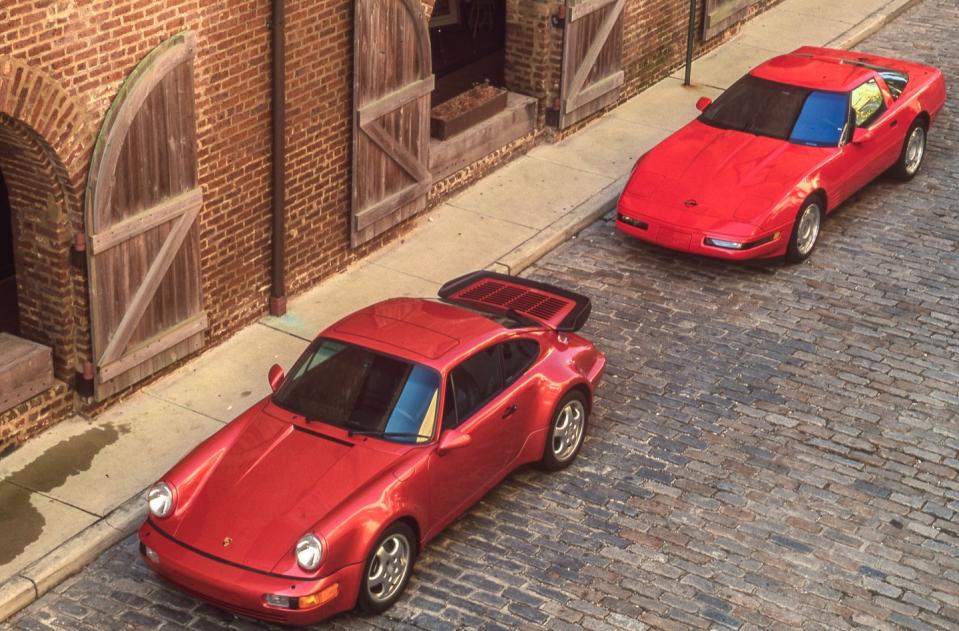
There is scant dissent that the ZR-1 is the most stupefying Corvette ever produced. In tests it has proved to be a true supercar, but it continues its roughneck tradition—heavy on brute force, dizzying speed, and race-car handling but lacking in grace and refinement. It's still a wild thing, one of the wildest automobiles this side of a $400,000 Ferrari F40.
Going into this test, the new 911 Turbo posed a number of questions. Its predecessors, sold here off and on since 1978, have had a legendary history of alternately delighting and intimidating their drivers. Their chassis had an ornery streak, their powerful turbocharged engines suffered from hairy all-or-nothing response to the throttle, and their price tags were funnier than Rodney Dangerfield. And, of course, their fat-fendered bodies looked mean enough to make Corollas quake.
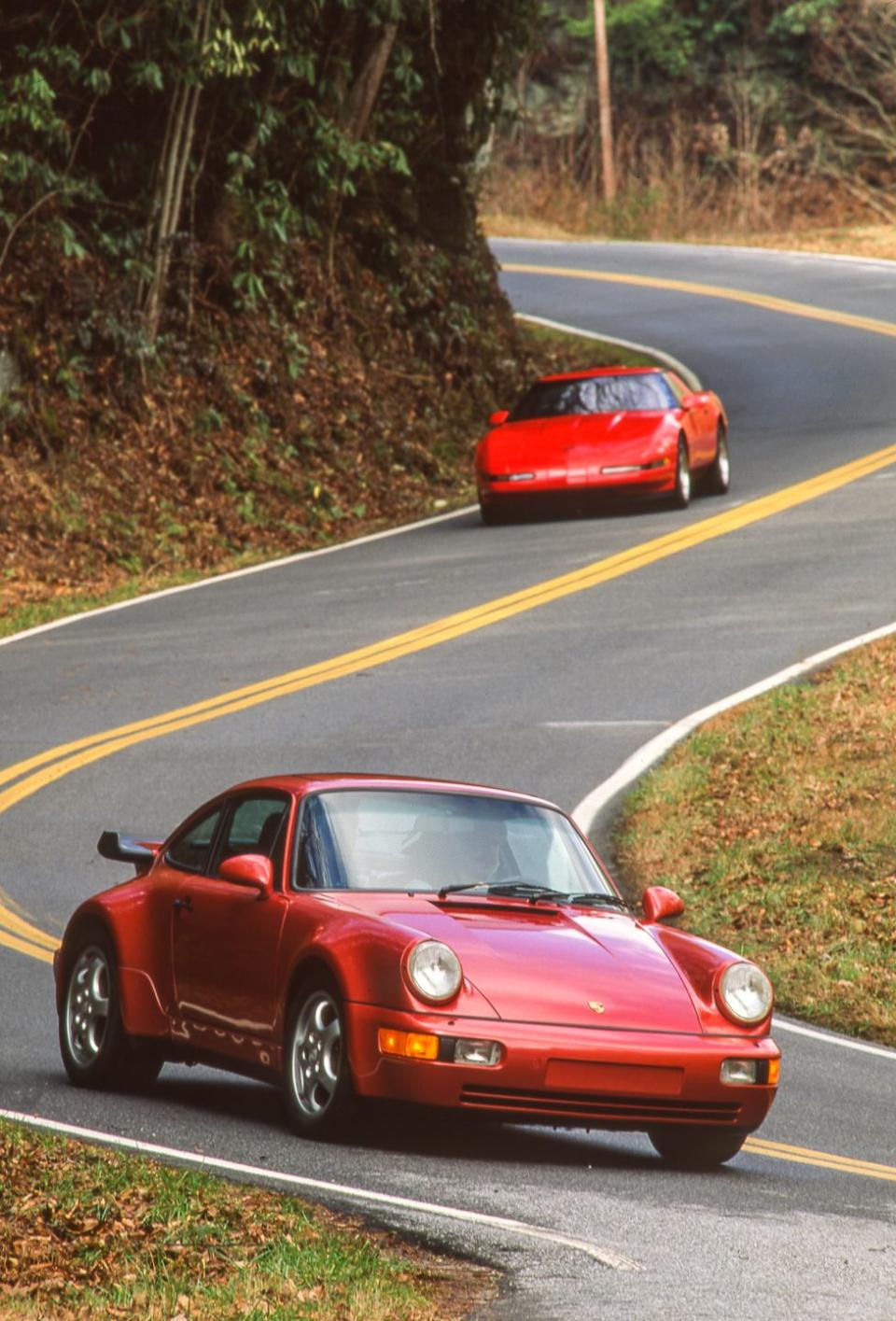
This new Porsche, however, is based on the thoroughly modernized Carrera 2 chassis. A perusal of its spec sheet indicates that it should be even hotter than before: its reworked 3.3-liter flat six is rated at 315 horsepower at 5750 rpm, up 33 horses from the last turbo. It boasts the fattest tires ever fitted to a 911 chassis. Its brake rotors are made from the same high-temperature alloy used on Porsche's 962 endurance racers. It packs an innovative limited-slip differential that not only improves driving traction, but can lock up under simultaneously braking and cornering to improve stability. But is this enough to make it the baddest cat in the asphalt jungle?
To find out, three C/D editors embarked on a three-day, 1300-mile, total-immersion experience. Hard driving had to be part of the trial, so we included a large dose of rural two-lane, and we dropped in at a race circuit to let these big cats really stretch out—the better to judge the capabilities of these nasty boys without worrying about sliding off into Uncle Fred's front yard.
There would be plenty of routine driving too: stop-and-go city traffic and long miles on Midwestern Interstates. After all, even a wild animal of the road is hemmed in by reality most of the time. Would either car be impossible to live with when the pace slowed down?Our trek began on the Atlantic docks in Charleston, South Carolina, where the Porsche Turbo arrived from Germany.
From Charleston we headed down the coast to Savannah, Georgia, home of the Roebling Road race circuit. Roebling's combination of ample straightaways and daunting high-speed sweeps was tailor-made for powerful sports cars.
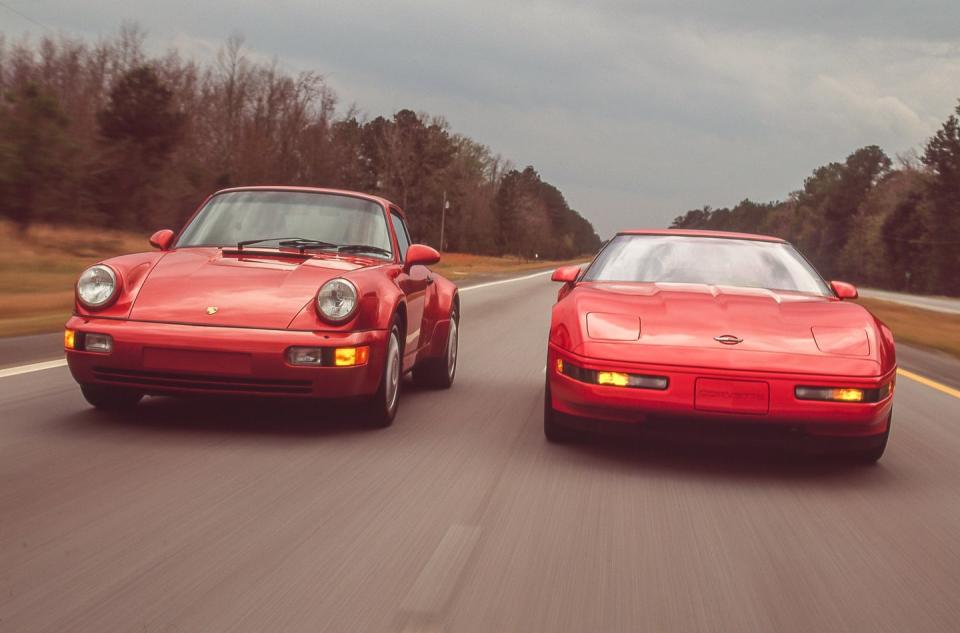
From there we scratched our way north on the kind of roads they write songs about: writhing two-lanes through North Carolina's Nantahala National Forest and the Great Smoky Mountains National Park (which North Carolina shares with Tennessee). We roared through enchanted forests and quiet valleys, past tin-roofed cabins with pungent smoke curling from their chimneys. The long final leg, Knoxville to Ann Arbor, was on mind-numbing Interstate.
But something else happens when you go on a long trip with cars of this nature. Cars like these can change your life, even if your affair with them is short. They confer power and authority and presence upon the driver. People respond differently around them. Things happen that feel extraordinary. You are stared at, examined, considered; the pedestrians wonder who you are. So, all the while, we were on another kind of uncharted trip, the route up in the head.
The effect is mildly narcotic, and it persuaded us to add a special category to the ratings chart that would reflect the mesmerizing effect these cars had on us and the people we came in contact with. We call it the "audacity rating."
Right here, pause and listen to the voice of another editor on the trip:
The convenience-store cashier tells us that Becky's Home Cooking Restaurant is only a few blocks away. But we are strangers, and the signs in Rosman, North Carolina, are not so clear to us Yankees, and soon we have to stop and ask again. We ask a telephone repairman. "Bake-ees ?"he says, correcting our Northern pronunciation. "Why, it's rayt dahn nair. Isstreet: raytdahnair. " So it is, and across the street is an audience: a dozen adolescents digging a drainpipe ditch for their high school. As we rumble toward them, the shoveling stops. Their heads swivel in unison, like deer sensing movement.
As we exit the lot after the meal, our audience is twirling their fingers at us, signaling us to squeal the tires. Leaving positive impressions on young minds is a civic duty, but we hesitate, noting a county patrol car parked up the street. Rich gets on the 911 anyway, but as soon as it heaves forward with boost, there is the officer, walking toward his car. Wheeeeeechugaluga ... the 911 lurches back down, and we coast by him at idle, looking straight ahead. Wonder if the kids got their nickel's worth... —Don Schroeder
Second Place: Porsche 911 Turbo
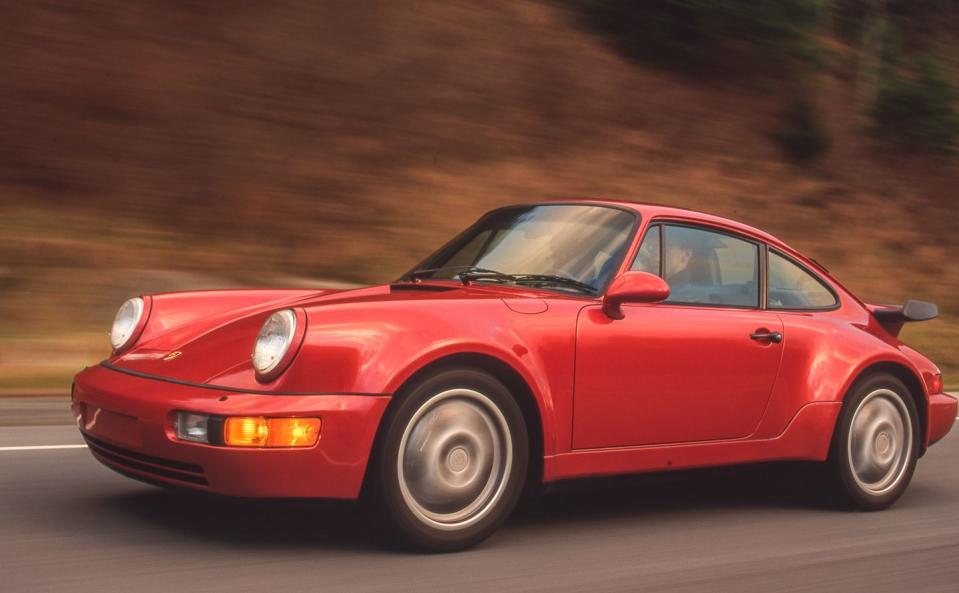
If audacity were all that counted, this contest would have been decided before it began. The 911 Turbo is Mr. Universe in a $1500 Italian suit. Its bulging sheetmetal and massive rear wing promise race-car performance. Its flawless bodywork and mirror-like finish suggest images of white-coated craftsmen fitting each part with meticulous care—which is not all that far from the truth. The car looks very, very expensive, which of course it is.
HIGHS: Sinus-clearing performance, 180-proof audacity.
LOWS: Looney Tunes price, nervous handling.
How expensive? Try $105,191. And our car came with just one add-on option: the $891 limited-slip differential. The price does include both the new federal luxury tax and the gas-guzzler tax.
For that kind of scratch, it's at least reassuring to discover that the 911 Turbo is rife with elegant engineering. The suspension's control arms are beautiful forged-alloy pieces. The brake rotors are cross-drilled like a race car's for maximum cooling. Look under the rear bumper's left corner and you'll notice that the turbocharger waste-gate outlet pipe is fitted with its own miniature catalytic converter.
The 911 Turbo's cabin is a mix of expensive Old World craftsmanship and just plain old. The soft leather on the four-spoke, air-bag-equipped wheel would do a very fine pair of gloves just swell. (You can option yourself to death as regards leather.) The pedals still hinge at the bottom, Beetle-style. Every piece of trim is impeccably battened down.
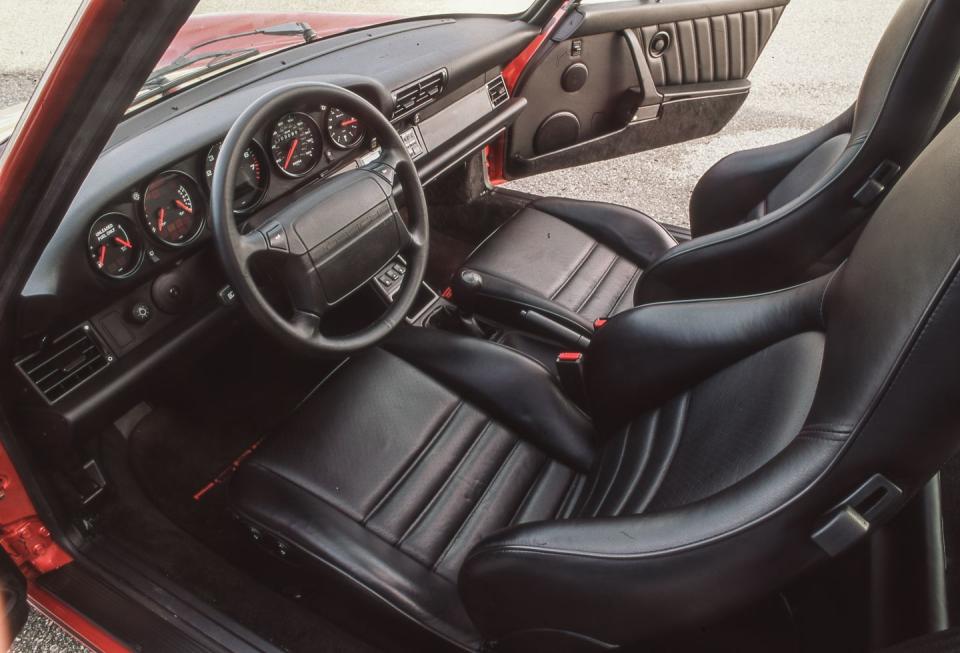
The dash remains the old 911 design: the gauge arrangement is still one of the best, with a tach the size of a salad plate located squarely in front of you. But the switchgear, much of it added over the years, is strewn about the instrument panel haphazardly. To Porsche's credit, it has managed to stuff a passenger-side air bag into the ancient dash layout.
Here's another voice:
Unlike the nasty north in winter, South Carolina is all sunshine, so Deputy Slide Rule Schroeder cannot tolerate one more minute behind the wheel of a Corvette ZR-1 coated with Kosher-size salt chunks and grease globules from Michigan and Ohio. We pull into Bob's Car Wash in Columbia. Bob's is crowded. Just before our turn on the roller track, we measure the Vette's left-rear tire to be sure it will fit. It's 12.75 inches wide; the track of the car wash is a tenth of an inch wider. Could be close. Ten feet into the wash, the Vette gets stuck, and refuses to move forward into its bath. Schroeder must back it out over the rollers, holding up a restless crowd. Luckily, they're too amused that our fancy car will have to be hand-washed in Bob's driveway to be angry. We don't get the Glow Wax, but we don't have to pay, either. Thanks, Bob. —Phil Berg
The view out of the 911 is very un-sports-car-like. You sit bolt upright in the deeply winged seats, and you crank the seatback up even further in order to make the long reach to the steering wheel. The 911 is noticeably taller than the Vette, five inches in fact. The front window is nearly vertical, and the hood is short—this is a rear-engined car, remember—so the view out is superb. Your field of vision could not be better even if you sat on the hood.
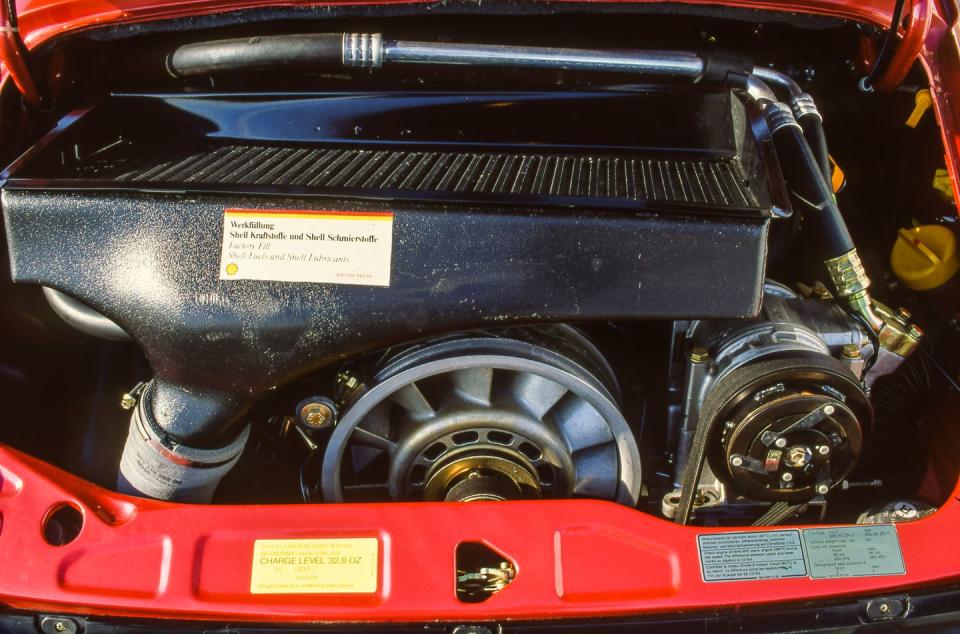
Even if Porsche had put a '51 Studebaker body over this chassis, you'd know what was underneath by the time you got a mile down the road. Everything your five senses register harks back through 25 years of Porsche 911 history. The engine, for instance, emits the same hard-edged thrum Porsche flat sixes have always made. And why not? It's a mildly reworked version of the previous model's single-turbo 3.3-liter powerplant. Even its Jekyll-and-Hyde personality is there, though more subtle than before. At low revs the big turbocharger is barely ticking over, and the engine feels like it has its feet up on the desk; you have time to recite the first stanza of Beowulf before the boost comes up. But above three grand, the 911 Turbo is on a caffeine high. Put your foot down and hold on: the speedo needle blurs past 60 mph in 4.4 seconds and you're through the quarter-mile in 12.9 seconds at 108 mph.
The Turbo's parentage really comes into focus when you press hard. Drive it to 85 percent of its cornering potential and it's sweet and sophisticated. It reacts confidently. The steering is sensitive and accurate, with just the right weighting. And no 911 Turbo was ever so stable in a straight line at speeds above the century mark.
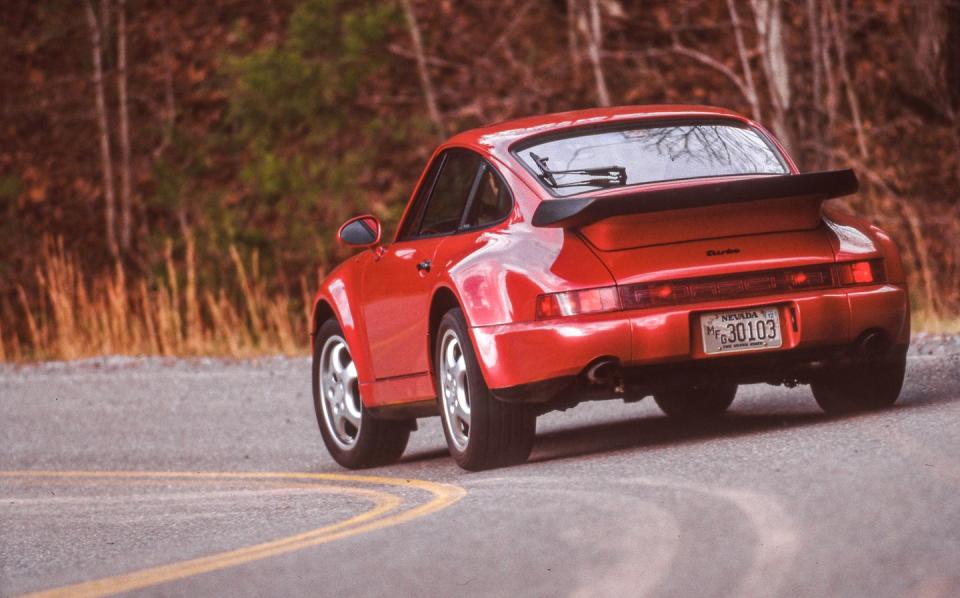
But turn it loose on a back road looking for that last fifteen percent and the Turbo acts up in much the manner of the previous version. It is a double handful in the corners, pitching and twitching like it longs to visit that ditch—a disobedient, thrusting animal trying to break its leash, or, if it doesn't get its way, its own neck. On the racetrack, the Turbo's mean streak made us conservative and kept it from getting within two seconds a lap of the ZR-1.
It sure sounded good:
What kind of noise does $170,000 buy? The right kind, if you're watching these cars from the finish line at the half-mile front straightaway of Roebling Road. Even under full throttle, the 911 Turbo approaches with an uncanny, freight-train-like silence. But as it passes, the hint of rushing wind transforms into an explosion of guttural ripping. On the other hand, the 911 is a gentleman compared with the ZR- 1, which, when flat out, seems like a car gone mad. Rounding the final curve in third gear, it cries out, clearly audible and urgent, its rising wail becoming almost frightening as it approaches and blasts past at more than 120 mph. A straining LT-5 is a great conversation stopper. —Don Schroeder

 Yahoo Autos
Yahoo Autos 